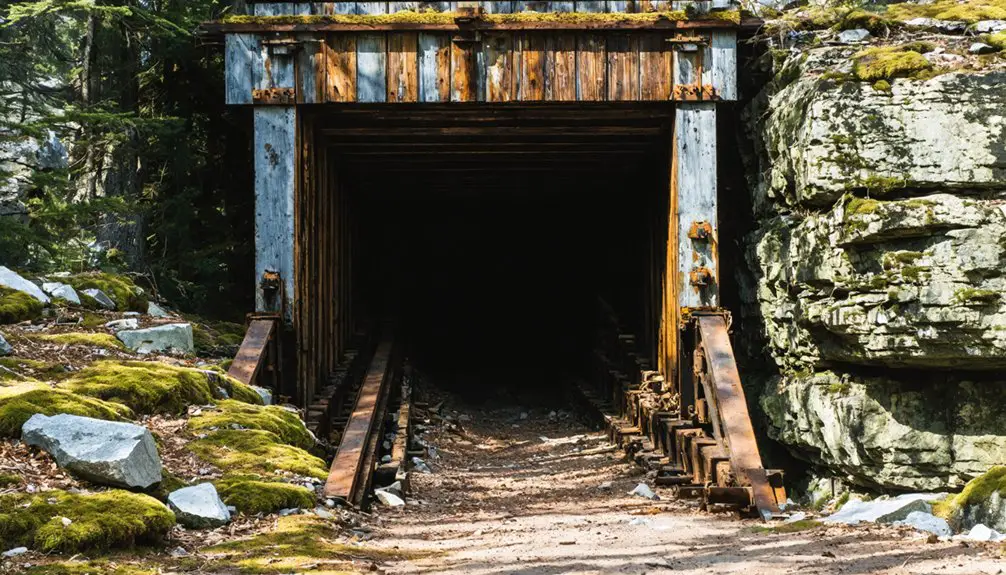You’ll find the remnants of Davis Mine Village in Rowe, Massachusetts, where iron pyrite mining operations transformed rural farmland into a bustling industrial community from 1882 to 1911. At its peak, the mine produced 150 tons of pyrite daily through four shafts, supporting 150 homes and modern amenities. After a catastrophic cave-in in 1909, the site gradually became a ghost town, leaving behind cellar holes, foundations, and tales of supernatural occurrences that continue to intrigue visitors today.
Key Takeaways
- Davis Mine Village operated as Massachusetts’ largest iron pyrite mine from 1882 to 1911, before becoming a ghost town.
- The town featured 150 homes, modern amenities, and four mining shafts during its peak industrial period.
- A catastrophic cave-in during 1909 led to the mine’s closure by 1911, causing rapid population decline.
- The area became known as “Dogtown,” with abandoned buildings serving as shelter for social outcasts.
- Over 150 cellar holes and building foundations remain today, marking the former mining community’s location.
The Rise of Davis Mine Village
When geology students from Amherst College discovered rich iron pyrite deposits in Rowe, Massachusetts in 1882, they set in motion the creation of what would become Davis Mine Village.
Ambitious New York entrepreneur Herbert Jerome Davis quickly recognized the area’s potential, purchasing local farms and ore-rich land to establish what would become Massachusetts’ largest pyrite mining operation.
Davis transformed rural Massachusetts farmland into an industrial empire by recognizing and seizing the potential of its rich pyrite deposits.
The village’s establishment coincided with the Second Industrial Revolution, transforming quiet rural farmland into a bustling mining community.
The development included a railway and mining school to support the growing industrial operations.
The mine operated successfully until poor leadership and dangerous cave-ins forced its closure in 1912.
You’ll find that the community dynamics evolved rapidly as miners and their families settled in, creating a distinctive industrial settlement.
This dramatic industrial change marked a defining moment in western Massachusetts’ development, as Davis Mine Village emerged as a symbol of the region’s evolution from agricultural roots to industrial prominence.
Mining Operations and Industrial Growth
You’ll find that Davis Mine’s industrial-scale pyrite extraction reached impressive heights during its peak years, with four operating shafts producing approximately 100 tons daily to meet the growing demand for sulfuric acid.
The mine’s sophisticated operations incorporated multiple shafts, including an enclosed headframe at Shaft #1, while workers extracted ore to depths of 200 feet using advanced techniques for the era. Similar to how Thing entities are classified in data frameworks, historical records needed careful documentation to distinguish this mining site from others with Davis place names.
The mine’s prosperity came to an abrupt end in 1911 when poor mining practices led to a collapse, forcing the closure of Massachusetts’ largest iron pyrite producer and ultimately contributing to the town’s abandonment.
Pyrite Mining Techniques
Mining operations at the Davis pyrite mine employed sophisticated extraction techniques through a network of four mining shafts, with Shaft #1 serving as the primary hub featuring an enclosed headframe and efficient tram system.
Underground techniques focused on extracting high-purity pyrite deposits embedded in hard gneiss and schist formations, reaching depths of 200 feet. The mine’s development was pioneered by H. J. Davis from 1882 to 1910. The facility included a blacksmith shop where tools were maintained and repaired for continuous mining operations.
- Miners tackled challenging ore extraction by working through dense rock to access lenticular masses of pyrite ranging from 7 to 20 feet thick.
- The operation achieved impressive daily outputs of up to 150 tons of pyrite during peak production.
- Secondary minerals like copper sulfides and chalcopyrite were also recovered during the mining process.
You’ll find the mine’s infrastructure was remarkably advanced for its time, featuring electric power and on-site processing facilities that supported these intensive extraction methods.
Peak Production Years
During its peak production years from 1882 to 1911, the Davis Pyrite Mine emerged as Massachusetts’ largest iron pyrite operation, yielding an impressive 100 tons of ore daily.
You’ll find the economic impact was substantial, with miners earning $12-15 per day – exceptional wages that attracted a skilled workforce to the region.
The mine’s success sparked remarkable community growth, transforming the area into a bustling industrial hub.
You’d have seen a thriving mining village with 150 homes, complete with modern amenities like electric lighting.
The infrastructure included four operational shafts, with Shaft #1 featuring an enclosed headframe and reduction works.
The operation’s scope extended beyond mining, as the camp supported local agriculture by purchasing substantial farm produce for its growing population.
Mine Collapse Impact
The catastrophic cave-in of July 1909 brought Davis Mine’s prosperous era to an abrupt end. Poor mining safety practices following Herbert Jerome Davis’s death in 1905 led to multiple structural failures, culminating in this devastating collapse.
The mine’s daily production of 100 tons of pyrite came to a halt, severely impacting the region’s economic resilience.
Here’s what you’ll find most compelling about the collapse’s industrial impact:
- The mine’s shutdown disrupted Massachusetts’ chemical supply chain during the Second Industrial Revolution
- High-paying mining jobs ($12-15/day) vanished, forcing workers to seek employment elsewhere
- Modern infrastructure, including electric lighting and reduction works, fell into disuse and abandonment
Daily Life in a 19th Century Mining Town
Life in Davis’s bustling mining settlement revolved around stark contrasts of grueling labor and basic survival.
You’d find families crammed into simple wooden cottages or tenements, where entire households shared just one or two rooms. Daily routines centered around the harsh realities of mining life – men descending into dangerous pits while women managed households, chopped wood, and preserved precious food supplies. Personal cleanliness was often neglected, as washing hands and faces was not yet a common practice. Women spent countless hours engaged in subsistence farming to supplement their meager food stores.
Your meals would’ve consisted mainly of basic staples like meal, peas, and oatmeal, though you might’ve added flavor with common spices like pepper and cinnamon.
Despite the hardships, community bonds formed through necessity. You’d rely on neighbors for support, sharing resources and labor.
While leisure time often meant rough entertainment like drinking and gambling, religious gatherings helped maintain social cohesion in this rugged environment.
The Fatal Collapse and Abandonment

Following years of declining maintenance and weak leadership after founder Davis’s death in 1905, catastrophic structural failure struck the Davis Pyrite Mine in 1911. The collapse causes stemmed from unsafe excavation methods and insufficient support structures, effectively ending the mine’s 30-year operation. Remarkably, despite the massive scale of the collapse, no fatalities occurred.
Poor leadership and unsafe mining practices sealed the fate of Davis Pyrite Mine, leading to its devastating collapse in 1911.
The community impact was swift and devastating:
- The mining camp’s population dwindled rapidly over two decades.
- By 1937, only a blacksmith shop and 150 cellar holes remained.
- The area earned the nickname “Dogtown” as abandoned buildings became shelter for outcasts.
You’ll find that this once-thriving industrial site transformed into a ghost town, following the classic boom-and-bust pattern of mining settlements. The mine, which was discovered by H.J. Davis himself, had been the largest iron pyrite operation in Massachusetts.
Today, the remnants serve as a reflection of the risks of poor mining practices and the fragility of resource-dependent communities.
Legends and Local Folklore
You’ll find the Davis ghost town‘s most enduring legends center around witchcraft, as local tales describe outcast women who squatted in abandoned homes and allegedly cast spells on passing merchants.
The supernatural reputation of the area intensified after the mine’s collapse, with stories of curses and malevolent forces becoming intertwined with the site’s tragic history.
These tales share strong parallels with the nearby Dogtown’s folklore, where similar accounts of witches and haunting figures emerged during the settlement’s decline in the 1830s.
Witchcraft Tales and Outcasts
When exploring the dark history of Davis, Massachusetts, you’ll discover a rich tapestry of witchcraft tales deeply rooted in the region’s connection to nearby Salem Village (later renamed Danvers).
The area’s witchcraft folklore emerged from a complex web of social tensions, where outcasts and marginalized individuals often became targets of suspicion and accusation.
- Stories of demonic visions, including black dogs, red cats, and a mysterious “tall man with white hair,” spread through the community.
- The practice of folk magic, like the “witch’s cake” ritual, was used to identify those supposedly afflicted by dark forces.
- Claims of spectral evidence and supernatural afflictions turned neighbor against neighbor, leading to tragic consequences for those accused.
The dark legacy of these witchcraft accusations continues to influence local legends, making Davis a haunting reminder of persecution’s toll on small communities.
Mine Collapse Supernatural Stories
Since the devastating 1911 mine collapse, the Davis Pyrite Mine has spawned numerous supernatural tales that interweave local history with haunting folklore.
You’ll hear stories of ghostly apparitions appearing near the 150 cellar holes and abandoned foundations, where locals claim to witness mysterious lights and hear unexplained voices echoing from sealed mine shafts.
The mine’s cursed grounds, marked by polluted waterways and dangerous sink holes, serve as a backdrop for legends about spirits who guard the underground passages.
These tales often feature phantom miners who appear near the old blacksmith shop and rusted machinery, warning trespassers of impending danger.
The site’s isolation in northwestern Massachusetts’s rolling hills only amplifies its reputation as a haunted reminder of industrial tragedy.
Exploring Davis Mine Today

Today, visitors to Davis Mine will discover a hauntingly beautiful ghost town nestled in the rolling hills of northwestern Massachusetts. This former mining powerhouse, once the largest iron pyrite operation in the state, now stands as an abandoned indication of its historical significance.
Hidden within Massachusetts’ hills lies Davis Mine, a ghostly reminder of the state’s once-mighty iron pyrite mining industry.
You’ll find remnants of mining infrastructure and roughly 150 cellar holes marking where buildings once stood.
For the adventurous explorer, here’s what you’ll need to know:
- Access the site via Davis Mine Road, located between Charlemont and Rowe at coordinates 42.69778°N, 72.87028°W
- Watch for hazards like unstable ground, hidden shafts, and deteriorating structures
- Plan your visit during spring or fall for ideal visibility through the vegetation
Remember to respect any posted warnings and private property boundaries while exploring these fascinating abandoned structures.
Archaeological Discoveries and Remnants
Archaeological investigations at Davis have uncovered a rich tapestry of structural remains and artifacts that paint a vivid picture of life in this former mining community.
You’ll find over 150 cellar holes scattered across the landscape, marking where homes once stood, while the blacksmith shop‘s foundation remains one of the few identifiable commercial structures.
Artifact analysis has revealed traces of both mining operations and domestic life, though a mine collapse in 1911 has complicated the site’s stratigraphy.
Of particular cultural significance are items potentially linked to the transient populations who occupied Davis after its abandonment, including folklore-associated artifacts from those labeled as outcasts and “witches.”
The site’s archaeological record spans from its 1882 founding through its final abandonment in 1937.
Preservation Efforts and Historical Significance

As the largest iron pyrite mine in Massachusetts during the late 19th century, Davis holds exceptional historical significance that has sparked various preservation initiatives over the decades.
Through community engagement and historical education efforts, you’ll find dedicated groups working to protect this fascinating ghost town’s legacy despite numerous challenges.
- Local historical societies and academic researchers collaborate to document remaining structures and collect oral histories.
- Volunteer groups maintain trails and stabilize structures while managing public access.
- Regional municipalities oversee site protection and promote educational programs about Davis’s mining heritage.
While preservation faces obstacles like natural overgrowth and structural instability, the site continues to serve as a valuable reflection of Massachusetts’ industrial past.
You’ll discover that partnerships between institutions and community volunteers remain vital in safeguarding this unique piece of mining history.
Planning Your Visit to Davis Ghost Town
Planning a visit to Davis Ghost Town requires careful preparation to guarantee both safety and an enriching historical experience. You’ll need to pack essential supplies, including water, food, and a first-aid kit, as there aren’t any facilities on-site.
Wear sturdy hiking boots and weather-appropriate clothing to navigate the rugged terrain safely. For ideal visitor safety, arrive during daylight hours and bring navigation tools like GPS or local maps.
Be prepared for wildlife encounters in the surrounding forest, and stay alert for physical hazards around the abandoned mining structures. It’s smart to inform someone of your plans before exploring this remote location.
Consider timing your visit during early morning or late afternoon for the best photography opportunities of the historic ruins and natural landscape.
Frequently Asked Questions
Are There Any Documented Deaths or Accidents From the Mine’s Operational Period?
While mining accidents were common during this era, you won’t find documented deaths at this specific mine. The only major incident was a non-fatal collapse in 1911 affecting worker safety.
What Happened to the Mining Equipment After the Site Was Abandoned?
You’ll find rusting remnants of mining equipment scattered across the overgrown site today – much was sealed in collapsed shafts, while other pieces were left to deteriorate naturally without proper site preservation.
How Deep Were the Mine Shafts, and Do They Still Exist?
You’ll find four mine shaft depths ranging from 200 to 1,800 feet. These abandoned tunnels still exist but they’re all capped off and secured, making them inaccessible for your exploration.
Did Native Americans Use or Mine This Area Before Davis Arrived?
Like footprints in time, you’ll find no direct evidence of Native American mining here, though the Naumkeag people used this land sustainably for seasonal living and spiritual practices of historical significance.
What Was the Average Wage for Miners Working at Davis Mine?
You’ll find that miners earned between $12-15 per day at their peak, which provided a strong miner livelihood. These average earnings were considered excellent pay for industrial workers in the late 1800s.
References
- https://newenglandwithlove.com/ghost-towns-in-massachusetts/
- https://historyofmassachusetts.org/ghost-towns-massachusetts/
- https://bostonuncovered.com/ghost-towns-massachusetts/
- https://en.wikipedia.org/wiki/Davis
- https://dbpedia.org/page/Davis
- https://freepages.history.rootsweb.com/~gtusa/usa/ma/davismine.htm
- https://www.mindat.org/loc-5972.html
- https://www.youtube.com/watch?v=AhI8ZCA01Oo
- https://pubs.usgs.gov/of/1979/0354/report.pdf
- https://www.gutenberg.org/files/43970/43970-h/43970-h.htm



